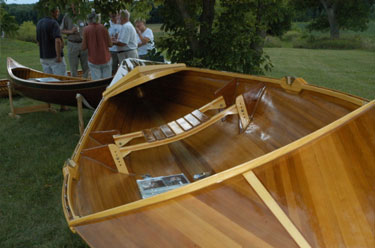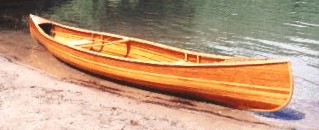
With a name like Bear Mountain Boat Shop , you would assume this is a place you could go to buy a boat, and for the most part, you’d be right. However, the first thing that Joan Barrett told me was that although they make boats and sell boat- building kits and plans, the main thing they’re known for is books telling people how to build boats.
Joan and her partner Ted Moores started this small company in 1977 to earn a peaceful living in the country and work at home. “At the time,” Joan told me, “Ted was a graphic artist, and I was working in communications. He always thought canoes looked like a neat product, and he decided to build one, even though he had no woodworking experience. He’s the kind of person who can look at something and figure out how it was built, and have faith in his ability to learn from books.”
“Ted used to have this cabin up north,” Joan continued, “and on his trips there, passed by a man who was building a wood strip canoe. He decided he could do that, and started building Sundance canoes in 1972. They were made with thin strips of wood and polyester resin. That method did not really catch on, though, because the polyester is messy to work with and tends to delaminate.
“A year later, Ted sold his business to Greavette, a boat-building company, and went to work for them. There he got to rub shoulders with more traditional boat builders.” He decided to move north to a property he and Joan owned, build a house and become self-employed. From 1974 to 1977, they built a stone house, worked other jobs, did some research and started reading wooden boat magazines.
“Meanwhile, the Gougeon brothers, who were catamaran racers and builders before becoming famous for West System epoxy, started experimenting with epoxy for boat building, and we did also. In 1977, we started building and selling canoes under the name Bear Mountain, but soon realized we had to be more diversified to make a living at it. Most people who make their living building wood canoes have a partner with a real job.

“By 1980, we had started building sprint racing canoes as well,” Joan recounted. “Soon people starting bringing their old canoes to us for restoration, an activity that launched Ted into researching the history of old construction methods. We also discovered that people were more interested in learning how to build their own canoes than buying a handcrafted one from us, so we decided to make kits and sell those. That led to people asking for just plans and instructions. In 1983, Ted teamed up with neighbor and writer Merilyn Simonds to write Canoecraft, his first book.” The book has since sold over 200,000 copies and is one of the seminal works in the field.
About the time the book emerged, Joan and Ted decided that living in the country had lost some of its allure. They sold their property in 1983 and moved to a location in central Ontario, where they began to restore classic runabouts and canoes while continuing to build racing canoes. They had work, but getting employees was not easy. “There were plenty of people who wanted to work for us,” explained Joan, “but they did not like the demanding nature of the work, or the pay scale. In spite of that, we sometimes had as many as five employees, but they did not stick around. We couldn’t compete with the pay you could get in a production shop or as a union carpenter. In addition, Ted needs his solitude to be creative, so that added another problem to the employee situation.

“Between 1983 and 1993, we did mostly boat restoration, winning awards for our work and developing some very good customers. The problem with restoration, though, is that you never know what you are getting into until you get the boat taken apart, so estimating a job was very difficult. We learned to choose only those customers who could afford the work and truly appreciated the craftsmanship, and those were few and far between.”
Meanwhile, the book was selling about 10,000 copies per year, and their two children were growing up. Their elder daughter wanted to go to a rather expensive school at the age of thirteen. “We were looking for something else we could do to amplify our income,” recalled Joan. “Our daughter suggested selling little canoes and offered to help if we started selling model kits. We bought a computer and developed scale-model kits for the canoes we build. Along with the drawings, we had to make miniature tools and parts and write instruction kits. Initially, we would photocopy the instructions, and the kids would bring their friends over to help them bind instructions, count parts, and package the kits. The kit project paid for her schooling.”
“Our younger daughter is very creative, and with her help, Ted launched into doing a second book, this time on kayak building. It was released in 1996 by a different publisher than the first one, and sadly, did not sell well.” That inspired them to focus more on plans. “We started doing plans more seriously, got a web site, and the business grew.”

Around the same time, the Canadian Canoe Museum obtained some buildings in Peterborough and asked Ted and Joan to help set up the museum. “Prior to getting the buildings,” Joan explained, “the museum had been a collection of boats stored all over the place in various barns and locations. That request inspired a move to Peterborough, where we helped establish the museum, set up a gift shop and the woodworking shop and helped move the collection to its present location.” While there, they suggested a coffee-table book based on the museum’s canoe collection, negotiated a contract with their favorite publisher and even wrote one chapter of The Canoe: A Living Tradition.
“In 1998,” Joan went on, “we started focusing more on our core business of building canoes, teaching classes on canoe and kayak building and selling books, plans, full-size kits, and model kits. We decided that we had not had time to do much travel, so in 2000, we went to Belize to teach canoe building for a man who had an eco-tourist resort and wanted to build one of our racing canoes — one thing for which we did not sell plans. Ever since, we’ve been going down once a year to teach. We’ve also produced a video on a big canoe race held down there. It’s all volunteer work, but it gets us away from here for a bit.”
As plywood kits became more popular, Ted wrote another book, this time outlining how to build his kayak kit, but also including more detailed instructions on building the kits of his two main competitors. “What Ted does really well is share his knowledge and expertise,” Joan pointed out. “Typically, canoe and boat builders have their secrets, but Ted is not like that. He likes to tell people how to do things. He’s very innovative, and likes to come up with creative solutions, even when it involves improving on the instructions for his competitors’ products.”

“Many of the sets of instructions on the market set you up for frustration because they imply you can build a canoe in sixty hours. You can’t. Instead, Ted breaks it down into a realistic time line over thirty days, with jobs that can be reasonably accomplished in manageable and predictable chunks of time.”
These days, they are keeping themselves sufficiently busy. “We shipped two 30′ racing canoes a couple weeks ago, are working on two more, have an apprentice from Belize, taught classes recently at a boat-building school and are building a row boat for our daughter. We are just getting ready to develop a launch powered by a hybrid diesel electric motor.” This will be their first motorboat, but one that is quieter and more fuel-efficient than usual and does not pollute. “You won’t even hear it,” insists Joan.
Browse the Bear Mountain web site and you’ll find that Joan and Ted offer the budding boat builder everything he or she will need to make an outstanding craft, from great advice to just the right parts. Perhaps, most important, they also serve up a healthy portion of encouragement.
“If people want to build a boat,” says Joan, “they can. All they need is a little help. With good instructions and plans, they can build something they will be very proud to own.”






